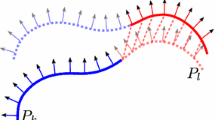Abstract
The reconstruction of rigid scenes from multiple images is a central topic in computer vision. Approaches merging partial 3D models in a hierarchical manner have proven the most effective to deal with large image sequences. One of the key building blocks of these hierarchical approaches is the alignment of two partial 3D models, which requires to express them in the same 3D coordinate frame by computing a 3D transformation. This problem has been well-studied for the cases of 3D models obtained with calibrated or uncalibrated pinhole cameras.
We tackle the problem of aligning 3D models – sets of 3D points – obtained using uncalibrated affine cameras. This requires to estimate 3D affine transformations between the models. We propose a factorization-based algorithm estimating simultaneously the aligning transformations and corrected points, exactly matching the estimated transformations, such that the reprojection error over all cameras is minimized. In the case of incomplete image data our algorithm uses an Expectation Maximization (EM) based scheme that alternates prediction of the missing data and estimation of the affine transformation.
We experimentally compare our algorithm to other methods using simulated and real data.
Preview
Unable to display preview. Download preview PDF.
Similar content being viewed by others
References
Fitzgibbon, A., Zisserman, A.: Automatic camera recovery for closed or open image sequences. In: ECCV, pp. 311–326 (1998)
Tomasi, C., Kanade, T.: Shape and motion from image streams under orthography: A factorization method. IJCV 9, 137–154 (1992)
Beardsley, P., Zisserman, A., Murray, D.: Sequential updating of projective and affine structure from motion. IJCV 23, 235–259 (1997)
Csurka, G., Demirdjian, D., Horaud, R.: Finding the collineation between two projective reconstructions. Comp. Vision and Image Underst. 75, 260–268 (1999)
Walker, M., Shao, L., Volz, R.: Estimating 3D location parameters using dual number quaternions. Computer Vision, Graphics and Image Processing: Image Understanding 54, 358–367 (1991)
Mundy, J., Zisserman, A. (eds.): Geometric Invariance in Computer Vision. MIT Press, Cambridge (1992)
Bartoli, A., Martinsson, H., Gaspard, F., Lavest, J.M.: On aligning sets of points reconstructed from uncalibrated affine cameras. In: SCIA, pp. 531–540 (2005)
Reid, I., Murray, D.: Active tracking of foveated feature clusters using affine structure. IJCV 18, 41–60 (1996)
Golub, G., van Loan, C.: Matrix Computation. Johns Hopkins University Press, Baltimore (1989)
Jacobs, D.: Linear fitting with missing data: Applications to structure-from-motion and to characterizing intensity images. In: CVPR, pp. 206–212 (1997)
McLachlan, G., Krishnan, T.: The EM algorithm and extensions. John Wiley & Sons, Inc., Chichester (1997)
Author information
Authors and Affiliations
Editor information
Editors and Affiliations
Rights and permissions
Copyright information
© 2005 Springer-Verlag Berlin Heidelberg
About this paper
Cite this paper
Martinsson, H., Bartoli, A., Gaspard, F., Lavest, JM. (2005). Handling Missing Data in the Computation of 3D Affine Transformations. In: Rangarajan, A., Vemuri, B., Yuille, A.L. (eds) Energy Minimization Methods in Computer Vision and Pattern Recognition. EMMCVPR 2005. Lecture Notes in Computer Science, vol 3757. Springer, Berlin, Heidelberg. https://doi.org/10.1007/11585978_7
Download citation
DOI: https://doi.org/10.1007/11585978_7
Publisher Name: Springer, Berlin, Heidelberg
Print ISBN: 978-3-540-30287-2
Online ISBN: 978-3-540-32098-2
eBook Packages: Computer ScienceComputer Science (R0)




